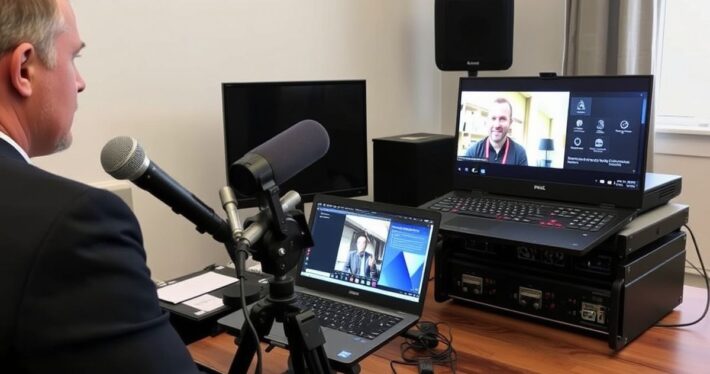Single Speaker vs. Multi-Speaker Webinars

Webinars have become a cornerstone of digital marketing, offering a dynamic way to educate, engage, and convert audiences. But when it comes to planning your webinar, one of the first decisions you’ll face is whether to go with a single speaker or multiple speakers. Each format has its unique strengths and challenges, and choosing the right one can make or break your event.
Let’s break it down: single-speaker webinars are streamlined and focused, while multi-speaker webinars bring diversity and expertise. But which one is better for your goals? In this article, we’ll dive deep into the pros and cons of each format, share real-world examples, and help you decide which approach will deliver the best results for your audience and objectives.
The Case for Single-Speaker Webinars
Single-speaker webinars are often the go-to choice for businesses—and for good reason. They’re simpler to organize, more consistent in delivery, and easier to brand. Here’s why they work:
1. Consistency and Focus
A single speaker means a single voice, which can create a cohesive narrative. Think about it: when you’re learning from one expert, the message is clear, and the flow is uninterrupted. This is especially important for webinars focused on education or technical topics, where consistency is key.
2. Easier to Produce
Coordinating schedules, managing multiple speakers, and ensuring everyone’s on the same page? That’s a lot of work. Single-speaker webinars reduce this complexity, making them ideal for businesses with limited resources or tight deadlines.
3. Stronger Personal Connection
One speaker can build a deeper rapport with the audience. When attendees feel like they’re having a one-on-one conversation with the presenter, they’re more likely to stay engaged and take action.
But let’s be honest—single-speaker webinars aren’t without their challenges. If the speaker isn’t dynamic or well-prepared, the webinar can fall flat. That’s why choosing the right presenter is critical.
The Power of Multi-Speaker Webinars
On the other hand, multi-speaker webinars bring a variety of perspectives, expertise, and energy to the table. Here’s what makes them stand out:
1. Diverse Expertise
Imagine a panel discussion where each speaker tackles a different aspect of the topic. This approach not only adds depth but also appeals to a broader audience. Plus, attendees get multiple takeaways, increasing the perceived value of the event.
2. Higher Engagement
Let’s face it: hearing multiple voices keeps things interesting. A well-structured multi-speaker webinar can feel more like a dynamic conversation than a lecture, which can boost engagement and retention.
3. Built-In Credibility
When you bring together multiple experts, you’re essentially amplifying the credibility of your event. This can be a game-changer for industries where authority and trust are paramount.
That said, multi-speaker webinars aren’t without their pitfalls. Coordinating schedules, managing egos, and ensuring a smooth flow can be a logistical nightmare. Without careful planning, the event can feel disjointed or overwhelming.
Real-World Example: Single vs. Multi-Speaker in Action
Let’s look at two examples.
Case Study 1: Single-Speaker Webinar
A SaaS company hosted a webinar with their founder as the sole speaker. The topic was “How to Scale Your Startup with Our Platform.” The founder shared personal stories, insights, and actionable steps, creating a strong emotional connection with the audience. The result? A 35% conversion rate on their premium offer.
Case Study 2: Multi-Speaker Webinar
A marketing agency organized a panel discussion with three industry experts to discuss “The Future of Digital Marketing in 2024.” Each speaker brought a unique perspective, and the event felt more like a lively debate than a traditional webinar. Attendees loved the diversity of opinions, and the agency saw a 50% increase in lead generation.
Both formats worked—but for different reasons. The single-speaker webinar excelled in storytelling and simplicity, while the multi-speaker webinar thrived on diversity and engagement.
Which Format is Right for You?
So, how do you choose? Here’s a quick checklist to help you decide:
| Factor | Single Speaker | Multi-Speaker |
|---|---|---|
| Complexity | Low | High |
| Engagement | Personal connection | Dynamic and diverse |
| Production Effort | Minimal | Moderate to high |
| Credibility | Depends on the speaker | Enhanced by multiple experts |
| Audience Appeal | Ideal for focused topics | Great for broad, multifaceted topics |
Pro Tip: If you’re new to webinars, start with a single-speaker format to keep things simple. As you gain experience and confidence, experiment with multi-speaker events to see how they resonate with your audience.
Final Thoughts
At the end of the day, there’s no one-size-fits-all answer—it’s all about aligning your format with your goals, audience, and resources. Whether you go with a single speaker or multiple speakers, the key is to deliver value and keep your audience engaged.
So, what’s your next move? Are you ready to take the stage solo, or will you assemble a dream team of experts? Either way, remember: the success of your webinar depends not just on who’s speaking, but on how well you connect with your audience.



